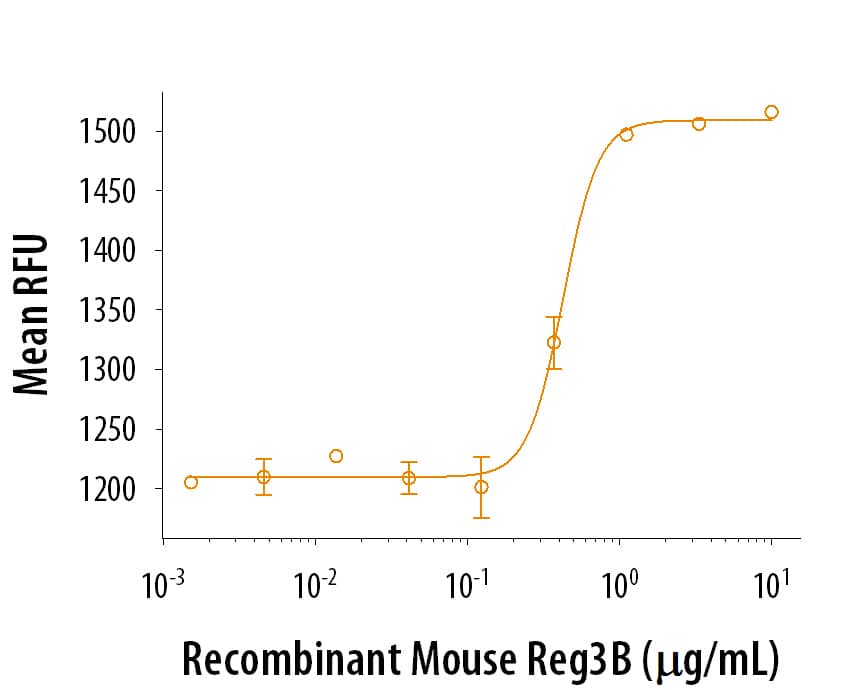Recombinant Mouse Reg3B Protein, CF
R&D Systems, part of Bio-Techne | Catalog # 5110-RG

Key Product Details
Product Specifications
Source
E. coli-derived mouse Reg3B protein
Glu27-Gly175, with an N-terminal Met
Glu27-Gly175, with an N-terminal Met
Purity
>95%, by SDS-PAGE with silver staining.
Endotoxin Level
<0.10 EU per 1 μg of the protein by the LAL method.
N-terminal Sequence Analysis
Met
Predicted Molecular Mass
17 kDa
SDS-PAGE
15 kDa, reducing conditions
Activity
Measured in a cell proliferation assay using RT4-D6P2T rat schwannoma cells.
The ED50 for this effect is typically 0.2-1 μg/mL.
The ED50 for this effect is typically 0.2-1 μg/mL.
Scientific Data Images for Recombinant Mouse Reg3B Protein, CF
Recombinant Mouse Reg3B Protein Bioactivity
Recombinant Mouse Reg3B stimulates cell proliferation in RT4‑D6P2T rat schwannoma cells. The ED50 for this effect is 0.2-1 μg/mL.Formulation, Preparation and Storage
5110-RG
| Formulation | Lyophilized from a 0.2 μm filtered solution in PBS. |
| Reconstitution |
Reconstitute at 500 μg/mL in PBS.
|
| Shipping | The product is shipped at ambient temperature. Upon receipt, store it immediately at the temperature recommended below. |
| Stability & Storage | Use a manual defrost freezer and avoid repeated freeze-thaw cycles.
|
Background: Reg3B
References
- Parikh, A. et al. (2012) Biomol. Concepts 3:57.
- Narushima, Y. et al. (1997) Gene 185:159.
- Mukherjee, S. et al. (2009) J. Biol. Chem. 284:4881.
- Lasserre, C. et al. (1999) Am. J. Pathol. 154:1601.
- Tebar, L.A. et al. (2008) Proc. Natl. Acad. Sci. USA 105:11400.
- Livesey, F.J. et al. (1997) Nature 390:614.
- Vasseur, S. et al. (2004) J. Biol. Chem. 279:7199.
- Xiong, X. et al. (2011) Am. J. Physiol. Endocrinol. Metab. 300:E669.
- Ogawa, H. et al. (2003) Inflamm. Bowel Dis. 9:162.
- Dessein, R. et al. (2009) Gut 58:771.
- Stelter, C. et al. (2011) PLoS ONE 6:e20749.
- van Ampting, M.T.J. et al. (2012) Infect. Immun. 80:1115.
- Miki, T. et al. (2012) J. Biol. Chem. 287:34844.
- Miki, T. and W-D. Hardt (2013) PLoS ONE 7:e69901.
- Gironella, M. et al. (2013) Cancer Res. 73:5682.
- Yun, J.W. et al. (2013) Free Radic. Biol. Med. 65C:291.
Long Name
Regenerating Islet-derived IIIb
Alternate Names
PAP1
Gene Symbol
REG3B
UniProt
Additional Reg3B Products
Product Documents for Recombinant Mouse Reg3B Protein, CF
Product Specific Notices for Recombinant Mouse Reg3B Protein, CF
For research use only
